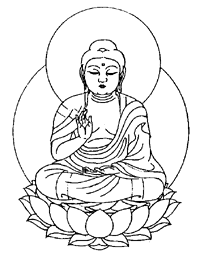|
Back | Home |Next
Description Of Form
His raised left hand represents that he is calling us to come
to him in our search for salvation. His right hand rests palm
open on his lap. He grasps his thumb with his four fingers, this
position represents that the Buddha is holding on tightly to those
who have come to him for protection. He is holding them tightly
to himself, therefore, they will not wander away into error and
danger.
Purpose and Vow
Over 2500 years ago, a young prince was born in north India and
his name was Gautama, Siddhartha (completed goal). His family
belonged to the Sakya clan and when after his years of religious
quest, he became Enlightened, he then came to be called the Sage
(Muni) of the Sakya clan, or Sakyamuni. This is the title of the
historic Buddha Sâkyamuni who was the founder of Buddhism.
Early in life Siddhartha was impressed with the suffering of this
world and with the suffering that we experience because of old
age, sickness, and death. He left the householder?s life and searched
out religious teachers who could teach him the meaning of life.
For six years, Siddhartha practiced painful austerities but with
no religious result. He discovered that self torture and total
self-denial were useless in the search for understanding. Instead
of attempting to totally control his body, he then began to control
his mind. One morning while seated under a large Bodhi Tree, he
attained supreme wisdom and understanding and became an awakened
being, or Buddha. After his enlightenment experience, he devoted
the rest of his life to wandering from place to place, preaching
to all who would listen to him. The Buddha died at age eighty.
Mantra
Nômaku Sammanda bodanan baku (Jpn.)
Namah samanta-buddhânâm bhah (Skt.)
Homage to all the Buddhas! bhah
  
Back | Home |Next
©1998 Shingon Buddhist International Institute
Deity line-art © Dashin Art, Inc. Used with Permission
|

